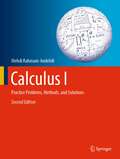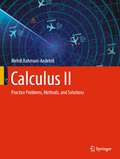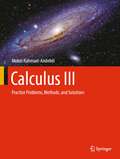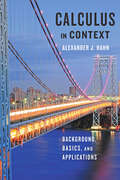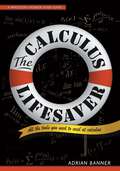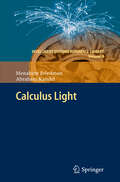- Table View
- List View
The Calculus Gallery: Masterpieces from Newton to Lebesgue (Princeton Science Library #60)
by William DunhamMore than three centuries after its creation, calculus remains a dazzling intellectual achievement and the gateway to higher mathematics. This book charts its growth and development by sampling from the work of some of its foremost practitioners, beginning with Isaac Newton and Gottfried Wilhelm Leibniz in the late seventeenth century and continuing to Henri Lebesgue at the dawn of the twentieth. Now with a new preface by the author, this book documents the evolution of calculus from a powerful but logically chaotic subject into one whose foundations are thorough, rigorous, and unflinching—a story of genius triumphing over some of the toughest, subtlest problems imaginable. In touring The Calculus Gallery, we can see how it all came to be.
Calculus: A Historical Approach (Undergraduate Texts in Mathematics)
by W.M. PriestleyThis book is for students being introduced to calculus, and it covers the usual topics, but its spirit is different from wh at might be expected. Though the approach is basically historical in nature, emphasis is put upon ideas and their place-not upon events and their dates. Its purpose is to have students to learn calculus first, and to learn incidentally something about the nature of mathematics. Somewhat to the surprise of its author, the book soon became animated by a spirit of opposition to the darkness that separates the sciences from the humanities. To fight the speil of that darkness anything at hand is used, even a few low tricks or bad jokes that seemed to offer a slight promise of success. To lighten the darkness, to illuminate some of the common ground shared by the two cultures, is a goal that justifies almost any means. It is possible that this approach may make calculus more fun as weil. Whereas the close ties of mathematics to the sciences are weil known, the ties binding mathematics to the humanities are rarely noticed. The result is a distorted view of mathematics, placing it outside the mainstream of liberal arts studies. This book tries to suggest gently, from time to time, where a kinship between mathematics and the humanities may be found.
Calculus I
by Brian KnightEach chapter in this book deals with a single mathematical topic, which ideally should form the basis of a single lecture. The chapter has been designed as a mixture of the following ingredients: -(i) Illustrative examples and notes for the student's pre-lecture reading. (ii) Class discussion exercises for study in a lecture or seminar. (iii) Graded problems for assignment work. Contents 1 Sets, functions page 11 2 Limits and continuity 17 3 The exponential and related functions 25 4 Inverse functions 30 5 Differentiation 35 6 Differentiation of implicit functions 44 7 Maxima and minima 50 8 Curve sketching 54 9 Expansion in series 61 10 Newton's method 67 11 Area and integration 72 12 Standard integrals 80 13 Applications of the fundamental theorem 87 14 Substitution in integrals 94 15 Use of partial fractions 100 16 Integration by parts 106 Answers to problems 110 Index 116 1 Sets, Functions A set is a collection of distinct objects. The objects be longing to a set are the elements (or members) of the set. Although the definition of a set given here refers to objects, we shall in fact take objects to be numbers throughout this book, i.e. we are concerned with sets of numbers. Illustrative Example 1: Set Notation We give straight away some examples of sets in set notation and explain the meaning in each case.
Calculus I (Undergraduate Texts in Mathematics)
by Jerrold Marsden Alan WeinsteinThe goal of this text is to help students learn to use calculus intelligently for solving a wide variety of mathematical and physical problems. This book is an outgrowth of our teaching of calculus at Berkeley, and the present edition incorporates many improvements based on our use of the first edition. We list below some of the key features of the book. Examples and Exercises The exercise sets have been carefully constructed to be of maximum use to the students. With few exceptions we adhere to the following policies. • The section exercises are graded into three consecutive groups: (a) The first exercises are routine, modelled almost exactly on the exam ples; these are intended to give students confidence. (b) Next come exercises that are still based directly on the examples and text but which may have variations of wording or which combine different ideas; these are intended to train students to think for themselves. (c) The last exercises in each set are difficult. These are marked with a star (*) and some will challenge even the best students. Difficult does not necessarily mean theoretical; often a starred problem is an interesting application that requires insight into what calculus is really about. • The exercises come in groups of two and often four similar ones.
Calculus I: Practice Problems, Methods, and Solutions
by Mehdi Rahmani-AndebiliThis study guide is designed for students taking a Calculus I course. This new edition includes expanded examples, questions, and practice problems that will help students to review and sharpen their knowledge of the subject and enhance their performance in the classroom. New material covered in the second edition includes types of functions, inverse functions, combinations of functions, domain and range of functions, axis of symmetry of functions, trigonometric equations and identities, limits and continuity, derivatives and their applications, and definite and indefinite integrals. Offering detailed solutions, multiple methods for solving problems, and clear explanations of concepts, this hands-on guide will improve students’ problem-solving skills and foster a solid understanding of calculus, which will benefit them in all of their calculus-based courses.
Calculus II (Undergraduate Texts in Mathematics)
by Jerrold Marsden Alan WeinsteinThe second of a three-volume work, this is the result of the authors'experience teaching calculus at Berkeley. The book covers techniques and applications of integration, infinite series, and differential equations, the whole time motivating the study of calculus using its applications. The authors include numerous solved problems, as well as extensive exercises at the end of each section. In addition, a separate student guide has been prepared.
Calculus II: Practice Problems, Methods, and Solutions
by Mehdi Rahmani-AndebiliThis study guide is designed for students taking a Calculus II course. The textbook includes examples, questions, and practice problems that will help students to review and sharpen their knowledge of the subject and enhance their performance in the classroom. The material covered in the book includes applications of integration, sequences and series and their applications, polar coordinate systems, and complex numbers. Offering detailed solutions, multiple methods for solving problems, and clear explanations of concepts, this hands-on guide will improve students’ problem-solving skills and foster a solid understanding of calculus, which will benefit them in all of their calculus-based courses
Calculus II For Dummies
by Mark ZegarelliAn easy-to-understand primer on advanced calculus topics Calculus II is a prerequisite for many popular college majors, including pre-med, engineering, and physics. Calculus II For Dummies offers expert instruction, advice, and tips to help second semester calculus students get a handle on the subject and ace their exams. It covers intermediate calculus topics in plain English, featuring in-depth coverage of integration, including substitution, integration techniques and when to use them, approximate integration, and improper integrals. This hands-on guide also covers sequences and series, with introductions to multivariable calculus, differential equations, and numerical analysis. Best of all, it includes practical exercises designed to simplify and enhance understanding of this complex subject. Introduction to integration Indefinite integrals Intermediate Integration topics Infinite series Advanced topics Practice exercises Confounded by curves? Perplexed by polynomials? This plain-English guide to Calculus II will set you straight!
Calculus II For Dummies
by Mark ZegarelliAn easy-to-understand primer on advanced calculus topics Calculus II is a prerequisite for many popular college majors, including pre-med, engineering, and physics. Calculus II For Dummies offers expert instruction, advice, and tips to help second semester calculus students get a handle on the subject and ace their exams. It covers intermediate calculus topics in plain English, featuring in-depth coverage of integration, including substitution, integration techniques and when to use them, approximate integration, and improper integrals. This hands-on guide also covers sequences and series, with introductions to multivariable calculus, differential equations, and numerical analysis. Best of all, it includes practical exercises designed to simplify and enhance understanding of this complex subject. Introduction to integration Indefinite integrals Intermediate Integration topics Infinite series Advanced topics Practice exercises Confounded by curves? Perplexed by polynomials? This plain-English guide to Calculus II will set you straight!
Calculus II For Dummies
by Mark ZegarelliThe easy (okay, easier) way to master advanced calculus topics and theories Calculus II For Dummies will help you get through your (notoriously difficult) calc class—or pass a standardized test like the MCAT with flying colors. Calculus is required for many majors, but not everyone’s a natural at it. This friendly book breaks down tricky concepts in plain English, in a way that you can understand. Practical examples and detailed walkthroughs help you manage differentiation, integration, and everything in between. You’ll refresh your knowledge of algebra, pre-calc and Calculus I topics, then move on to the more advanced stuff, with plenty of problem-solving tips along the way. Review Algebra, Pre-Calculus, and Calculus I concepts Make sense of complicated processes and equations Get clear explanations of how to use trigonometry functions Walk through practice examples to master Calc IIUse this essential resource as a supplement to your textbook or as refresher before taking a test—it’s packed with all the helpful knowledge you need to succeed in Calculus II.
Calculus II For Dummies
by Mark ZegarelliThe easy (okay, easier) way to master advanced calculus topics and theories Calculus II For Dummies will help you get through your (notoriously difficult) calc class—or pass a standardized test like the MCAT with flying colors. Calculus is required for many majors, but not everyone’s a natural at it. This friendly book breaks down tricky concepts in plain English, in a way that you can understand. Practical examples and detailed walkthroughs help you manage differentiation, integration, and everything in between. You’ll refresh your knowledge of algebra, pre-calc and Calculus I topics, then move on to the more advanced stuff, with plenty of problem-solving tips along the way. Review Algebra, Pre-Calculus, and Calculus I concepts Make sense of complicated processes and equations Get clear explanations of how to use trigonometry functions Walk through practice examples to master Calc IIUse this essential resource as a supplement to your textbook or as refresher before taking a test—it’s packed with all the helpful knowledge you need to succeed in Calculus II.
Calculus II Workbook For Dummies
by Mark ZegarelliWork your way through Calc 2 with crystal clear explanations and tons of practice Calculus II Workbook For Dummies is a hands-on guide to help you practice your way to a greater understanding of Calculus II. You’ll get tons of chances to work on intermediate calculus topics such as substitution, integration techniques and when to use them, approximate integration, and improper integrals. This book is packed with practical examples, plenty of practice problems, and access to online quizzes so you’ll be ready when it’s test time. Plus, every practice problem in the book and online has a complete, step-by-step answer explanation. Great as a supplement to your textbook or a refresher before taking a standardized test like the MCAT, this Dummies workbook has what you need to succeed in this notoriously difficult subject. Review important concepts from Calculus I and pre-calculus Work through practical examples for integration, differentiation, and beyond Test your knowledge with practice problems and online quizzes—and follow along with step-by-step solutions Get the best grade you can on your Calculus II examCalculus II Workbook For Dummies is an essential resource for students, alone or in tandem with Calculus II For Dummies.
Calculus II Workbook For Dummies
by Mark ZegarelliWork your way through Calc 2 with crystal clear explanations and tons of practice Calculus II Workbook For Dummies is a hands-on guide to help you practice your way to a greater understanding of Calculus II. You’ll get tons of chances to work on intermediate calculus topics such as substitution, integration techniques and when to use them, approximate integration, and improper integrals. This book is packed with practical examples, plenty of practice problems, and access to online quizzes so you’ll be ready when it’s test time. Plus, every practice problem in the book and online has a complete, step-by-step answer explanation. Great as a supplement to your textbook or a refresher before taking a standardized test like the MCAT, this Dummies workbook has what you need to succeed in this notoriously difficult subject. Review important concepts from Calculus I and pre-calculus Work through practical examples for integration, differentiation, and beyond Test your knowledge with practice problems and online quizzes—and follow along with step-by-step solutions Get the best grade you can on your Calculus II examCalculus II Workbook For Dummies is an essential resource for students, alone or in tandem with Calculus II For Dummies.
Calculus III (Undergraduate Texts in Mathematics)
by Jerrold Marsden Alan WeinsteinThe third of a three-volume work, this book is the outgrowth of the authors' experience teaching calculus at Berkeley. It covers multivariable calculus and begins with the necessary material from analytical geometry. It goes on to cover partial differention, the gradient and its applications, multiple integration, and the theorems of Green, Gauss and Stokes. The authors motivate the study of calculus using its applications. Features many solved problems and extensive exercises.
Calculus III: Practice Problems, Methods, and Solutions
by Mehdi Rahmani-AndebiliThis study guide is designed for students taking a Calculus III course. The textbook includes examples, questions, and practice problems that will help students to review and sharpen their knowledge of the subject and enhance their performance in the classroom. The material covered in the book includes linear algebra and analytical geometry; lines, surfaces, and vector functions in three-dimensional coordinate systems; multiple-variable functions; multiple integrals and their applications; line integrals and their applications. Offering detailed solutions, multiple methods for solving problems, and clear explanations of concepts, this hands-on guide will improve students’ problem-solving skills and foster a solid understanding of calculus, which will benefit them in all of their calculus-based courses.
Calculus in Context: Background, Basics, and Applications
by Alexander J. HahnBreaking the mold of existing calculus textbooks, Calculus in Context draws students into the subject in two new ways. Part I develops the mathematical preliminaries (including geometry, trigonometry, algebra, and coordinate geometry) within the historical frame of the ancient Greeks and the heliocentric revolution in astronomy. Part II starts with comprehensive and modern treatments of the fundamentals of both differential and integral calculus, then turns to a wide-ranging discussion of applications. Students will learn that core ideas of calculus are central to concepts such as acceleration, force, momentum, torque, inertia, and the properties of lenses. Classroom-tested at Notre Dame University, this textbook is suitable for students of wide-ranging backgrounds because it engages its subject at several levels and offers ample and flexible problem set options for instructors. Parts I and II are both supplemented by expansive Problems and Projects segments. Topics covered in the book include:;€¢ the basics of geometry, trigonometry, algebra, and coordinate geometry and the historical, scientific agenda that drove their development;€¢ a brief, introductory calculus from the works of Newton and Leibniz;€¢ a modern development of the essentials of differential and integral calculus;€¢ the analysis of specific, relatable applications, such as the arc of the George Washington Bridge; the dome of the Pantheon; the optics of a telescope; the dynamics of a bullet; the geometry of the pseudosphere; the motion of a planet in orbit; and the momentum of an object in free fall.Calculus in Context is a compelling exploration;¢;‚¬;€?for students and instructors alike;¢;‚¬;€?of a discipline that is both rich in conceptual beauty and broad in its applied relevance.
Calculus in Context: Background, Basics, and Applications
by Alexander J. HahnBreaking the mold of existing calculus textbooks, Calculus in Context draws students into the subject in two new ways. Part I develops the mathematical preliminaries (including geometry, trigonometry, algebra, and coordinate geometry) within the historical frame of the ancient Greeks and the heliocentric revolution in astronomy. Part II starts with comprehensive and modern treatments of the fundamentals of both differential and integral calculus, then turns to a wide-ranging discussion of applications. Students will learn that core ideas of calculus are central to concepts such as acceleration, force, momentum, torque, inertia, and the properties of lenses. Classroom-tested at Notre Dame University, this textbook is suitable for students of wide-ranging backgrounds because it engages its subject at several levels and offers ample and flexible problem set options for instructors. Parts I and II are both supplemented by expansive Problems and Projects segments. Topics covered in the book include:;€¢ the basics of geometry, trigonometry, algebra, and coordinate geometry and the historical, scientific agenda that drove their development;€¢ a brief, introductory calculus from the works of Newton and Leibniz;€¢ a modern development of the essentials of differential and integral calculus;€¢ the analysis of specific, relatable applications, such as the arc of the George Washington Bridge; the dome of the Pantheon; the optics of a telescope; the dynamics of a bullet; the geometry of the pseudosphere; the motion of a planet in orbit; and the momentum of an object in free fall.Calculus in Context is a compelling exploration;¢;‚¬;€?for students and instructors alike;¢;‚¬;€?of a discipline that is both rich in conceptual beauty and broad in its applied relevance.
Calculus in Vector Spaces, Revised Expanded
by Lawrence CorwinCalculus in Vector Spaces addresses linear algebra from the basics to the spectral theorem and examines a range of topics in multivariable calculus. This second edition introduces, among other topics, the derivative as a linear transformation, presents linear algebra in a concrete context based on complementary ideas in calculus, and explains differential forms on Euclidean space, allowing for Green's theorem, Gauss's theorem, and Stokes's theorem to be understood in a natural setting. Mathematical analysts, algebraists, engineers, physicists, and students taking advanced calculus and linear algebra courses should find this book useful.
Calculus in Vector Spaces, Revised Expanded (Pure And Applied Mathematics Ser. #Vol. 52)
by Lawrence CorwinCalculus in Vector Spaces addresses linear algebra from the basics to the spectral theorem and examines a range of topics in multivariable calculus. This second edition introduces, among other topics, the derivative as a linear transformation, presents linear algebra in a concrete context based on complementary ideas in calculus, and explains differential forms on Euclidean space, allowing for Green's theorem, Gauss's theorem, and Stokes's theorem to be understood in a natural setting. Mathematical analysts, algebraists, engineers, physicists, and students taking advanced calculus and linear algebra courses should find this book useful.
Calculus: A Liberal Art (Undergraduate Texts in Mathematics)
by W.M. PriestleyPresenting mathematics as forming a natural bridge between the humanities and the sciences, this book makes calculus accessible to those in the liberal arts. Much of the necessary geometry and algebra are exposed through historical development, and a section on the development of calculus offers insights into the place of mathematics in the history of thought.
The Calculus Lifesaver: All the Tools You Need to Excel at Calculus
by Adrian BannerFor many students, calculus can be the most mystifying and frustrating course they will ever take. The Calculus Lifesaver provides students with the essential tools they need not only to learn calculus, but to excel at it. All of the material in this user-friendly study guide has been proven to get results. The book arose from Adrian Banner's popular calculus review course at Princeton University, which he developed especially for students who are motivated to earn A's but get only average grades on exams. The complete course will be available for free on the Web in a series of videotaped lectures. This study guide works as a supplement to any single-variable calculus course or textbook. Coupled with a selection of exercises, the book can also be used as a textbook in its own right. The style is informal, non-intimidating, and even entertaining, without sacrificing comprehensiveness. The author elaborates standard course material with scores of detailed examples that treat the reader to an "inner monologue"--the train of thought students should be following in order to solve the problem--providing the necessary reasoning as well as the solution. The book's emphasis is on building problem-solving skills. Examples range from easy to difficult and illustrate the in-depth presentation of theory. The Calculus Lifesaver combines ease of use and readability with the depth of content and mathematical rigor of the best calculus textbooks. It is an indispensable volume for any student seeking to master calculus. Serves as a companion to any single-variable calculus textbook Informal, entertaining, and not intimidating Informative videos that follow the book--a full forty-eight hours of Banner's Princeton calculus-review course--is available at Adrian Banner lectures More than 475 examples (ranging from easy to hard) provide step-by-step reasoning Theorems and methods justified and connections made to actual practice Difficult topics such as improper integrals and infinite series covered in detail Tried and tested by students taking freshman calculus
The Calculus Lifesaver: All the Tools You Need to Excel at Calculus
by Adrian BannerFor many students, calculus can be the most mystifying and frustrating course they will ever take. The Calculus Lifesaver provides students with the essential tools they need not only to learn calculus, but to excel at it. All of the material in this user-friendly study guide has been proven to get results. The book arose from Adrian Banner's popular calculus review course at Princeton University, which he developed especially for students who are motivated to earn A's but get only average grades on exams. The complete course will be available for free on the Web in a series of videotaped lectures. This study guide works as a supplement to any single-variable calculus course or textbook. Coupled with a selection of exercises, the book can also be used as a textbook in its own right. The style is informal, non-intimidating, and even entertaining, without sacrificing comprehensiveness. The author elaborates standard course material with scores of detailed examples that treat the reader to an "inner monologue"--the train of thought students should be following in order to solve the problem--providing the necessary reasoning as well as the solution. The book's emphasis is on building problem-solving skills. Examples range from easy to difficult and illustrate the in-depth presentation of theory. The Calculus Lifesaver combines ease of use and readability with the depth of content and mathematical rigor of the best calculus textbooks. It is an indispensable volume for any student seeking to master calculus. Serves as a companion to any single-variable calculus textbook Informal, entertaining, and not intimidating Informative videos that follow the book--a full forty-eight hours of Banner's Princeton calculus-review course--is available at Adrian Banner lectures More than 475 examples (ranging from easy to hard) provide step-by-step reasoning Theorems and methods justified and connections made to actual practice Difficult topics such as improper integrals and infinite series covered in detail Tried and tested by students taking freshman calculus
Calculus Light (Intelligent Systems Reference Library #9)
by Menahem Friedman Abraham KandelAnother Calculus book? As long as students find calculus scary, the failure rate in mathematics is higher than in all other subjects, and as long as most people mistakenly believe that only geniuses can learn and understand mathematics, there will always be room for a new book of Calculus. We call it Calculus Light.This book is designed for a one semester course in "light" calculus – mostly single variable, meant to be used by undergraduate students without a wide mathematical background and who do not major in mathematics but study subjects such as engineering, biology or management information systems. The first chapter contains a historical background of calculus. Every scientific achievement involves people and therefore characterized by victories and disappointments, intrigues and hope. All of these elements exist in the story behind calculus and when you add the time dimension, starting 2400 years ago, it is a saga. We hope the reader enjoys reading this chapter as much as we enjoyed the writing.In addition to classic calculus the book provides tools for practical applications such as Fourier series, Lagrange multipliers and elementary numerical methods.




